The dumbbell reverse curl is a variation of the standard dumbbell biceps curl in which you hold the dumbbells with your palms facing down (overhead grip).
Reverse dumbbell curls are a classic biceps curl exercise used for decades by bodybuilders and strength athletes. They are a highly effective way to target the forearm and bicep muscles.
It trains the muscles of the bicep, brachialis (upper arms) and brachioradialis (lower arm).
You can do dumbbell reverse curls at home or the gym as part of a full-body or targeted arm workout.
There are many variations of reverse grip dumbbell curl that you can add to your workout routine, and each has its unique benefits.
- Alternating Reverse Grip Dumbbell Curl
- Single-Arm Reverse Curl
- Preacher Bench Reverse Dumbbell Curl
- Incline Curl With Reverse Grip
- Reverse Grip Spider Dumbbell Curl
Use Our Free Calculator To Know Your Calories Requirement To Gain Muscle Mass
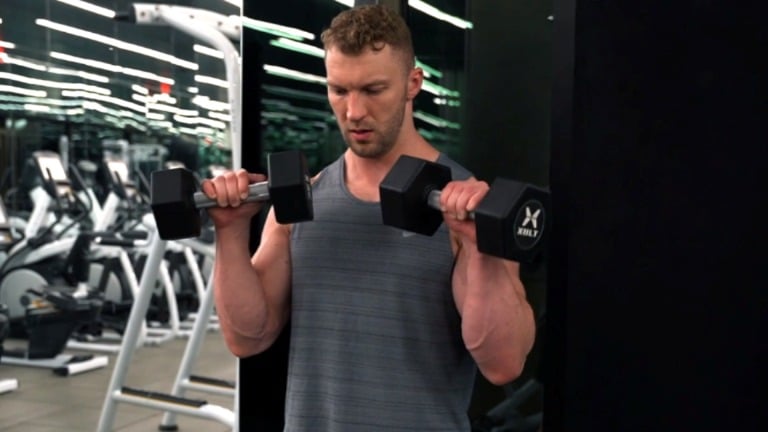
- Dumbbell Reverse Curl Muscles Worked
- How To Do Standing Dumbbell Reverse Curl
- Proper Form And Technique
- Variations Of Reverse Grip Dumbbell Curls
- 1. Dumbbell Reverse Grip Concentration Curl
- 2. Dumbbell Reverse Bicep Preacher Curl
- 3. Reverse Grip Dumbbell Spider Curl
- 4. Reverse Incline Dumbbell Curl
- 5. Standing One Arm Dumbbell Reverse Curl
- 6. Seated Reverse Dumbbell Curl
- Add Dumbbell Reverse Curl Into Your Workout Routine
- 1. Bicep-Focused Workout Routine
- 2. Pull Workout Routine
- FAQs
- Do reverse curls build forearms?
- Why are reverse curls so hard?
- Why do reverse curls hurt my elbows?
Dumbbell Reverse Curl Muscles Worked
- The dumbbell reverse curl primarily targets the muscles in the forearm, specifically the brachioradialis.
- Additionally, other muscles come into play as secondary stabilizers during the reveres grip dumbbell curl: Biceps Brachii, Brachialis,
- A handful of other muscles work or play the role of stabilizer muscles, including your Wrist Extensors, flexors, and Rectus abdominis. The deltoids and trapezius muscles are also active, but only for body stabilization.

How To Do Standing Dumbbell Reverse Curl
- Stand with your feet shoulder-width apart and your knees slightly bent.
- Grab a dumbbell in each hand using an overhand grip (palm facing down).
- Keep your upper arms stationary and your back straight.
- Exhale and Curl the Dumbbell towards your shoulders.
- Continue curling the dumbbells until they are at shoulder level.
- Pause at the top of the movement, then slowly lower the dumbbells back down to the starting position.
- Repeat for the desired 8–12 reps and 3–4 sets.
Know More: 12 Best Ways To Do Bicep Curl (Dumbbell, Barbell & Cable)
Proper Form And Technique
Proper exercise form and technique are essential to ensure the safety and effectiveness of an exercise program.
- Don’t lift the weight with too much momentum or swing your body.
- Pause at the top of the movement and squeeze your biceps and brachialis muscles.
- A slow controlled descent will increase time under tension, leading to more effective sets and less risk of injury.
- Ensure your elbows stay close to your sides; they should not move forward or outward.
- Don’t let your shoulders shrug up towards your ears.
- Incorporate proper warm-ups, rest, and nutrition into your exercise program.
- Rest for 24 to 48 hours before training the same muscle groups to allow sufficient recovery.
- Perform this exercise in a slow, controlled manner for best results.
- Don’t go heavy. Choose a lighter weight and focus on perfecting your form.
- The number of reps you should do depends on your goals, whether to increase strength or build muscle mass and endurance. For muscle growth, it is best to do for around 6–12 reps per set and for muscle Endurance, do 15-20+ reps per set.
| Level | Sets | Reps | Frequency |
|---|---|---|---|
| Beginner | 2-3 | 8-12 | 1-2 times per week |
| Intermediate | 3-4 | 8-12 | 2-3 times per week |
| Advanced | 4-5 | 8-15 | 2-3 times per week |
Know More: 15 Best Biceps Exercises With Dumbbells For Mass & Strength
Variations Of Reverse Grip Dumbbell Curls
Several variations of reverse curls can target different areas of your biceps and forearms.
- If you are new to dumbbell reverse curl, you may want to apply a few modifications to make the exercise easier. One way to counter this problem is to use a lighter weight. Another option is to do a single-arm reverse curl.
- If you want a more advanced variation to stimulate different muscle fibers in the bicep, try preacher reverse grip and spider reverse curl.
1. Dumbbell Reverse Grip Concentration Curl
Due to its isolated nature, the concentration curl is known for promoting a strong mind-muscle connection.
The reverse grip variation can strengthen this connection even more because it requires more focus and control to effectively target the brachioradialis and brachialis muscles.
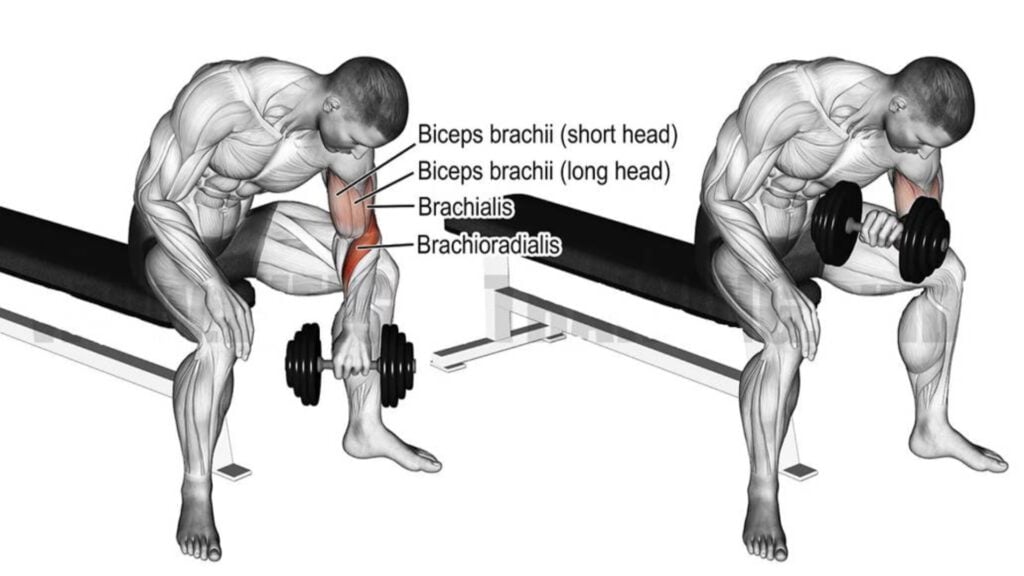
2. Dumbbell Reverse Bicep Preacher Curl
The preacher bench isolates the biceps by removing involvement from other muscle groups, such as the shoulders and back. This allows you to fully fatigue them through a full range of motion.
The reverse bicep preacher curl may be performed with a barbell, dumbbells, or EZ-curl bar. However, the dumbbell reverse grip preacher curl provides better stability and the full range of motion.
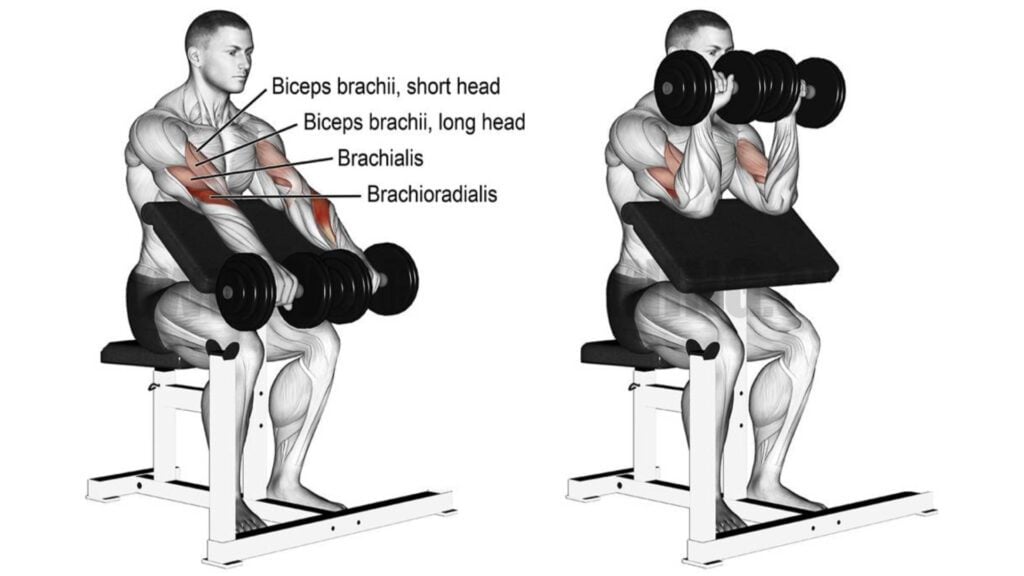
3. Reverse Grip Dumbbell Spider Curl
Dumbbell Reverse spider curl is a variation of the spider curl where the dumbbell is gripped palm down. The motion is the same, but the change in grip allows specific arm muscles to be targeted.
The reverse grip places a significant emphasis on the brachioradialis muscle. Strengthening this muscle improves forearm strength and stability, which in turn improves grip strength and pulling movements.

4. Reverse Incline Dumbbell Curl
The reverse grip used in the incline curl emphasizes the brachialis and brachioradialis muscles.
The reverse grip used in this variation challenges the grip strength and forearm muscles more, which helps you develop a stronger grip.
5. Standing One Arm Dumbbell Reverse Curl
The one-arm variation allows you to isolate each forearm independently. This can fix any muscle imbalances between your forearms and ensure that both sides develop evenly.
It is especially helpful if you have noticed that one forearm is weaker than the other. It also leads to better mind-muscle connections.
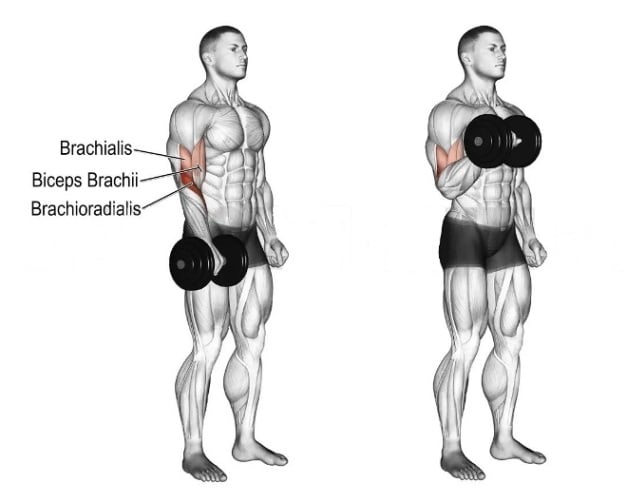
6. Seated Reverse Dumbbell Curl
As the name suggests, this variation is performed sitting on a bench or chair. This allows you to better isolate the arm muscles with minimal involvement of other body parts.
When seated, there’s less opportunity for body movement or momentum to assist in lifting the weight. This means you’re less likely to “cheat” by using your upper body to complete the movement.
This can benefit individuals with lower back issues or those looking to minimize strain on the spine and knee joints.
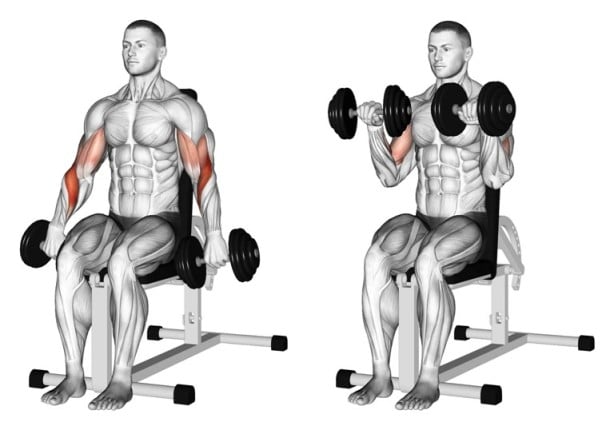
Add Dumbbell Reverse Curl Into Your Workout Routine
The reverse dumbbell curls can be incorporated into your workout routine in various ways. Here are some options:
- As a standalone exercise: Do on 3-4 sets of 8-12 reps.
- As part of a bicep workout, Do 3-4 sets of 8-12 reps along with other bicep exercises, such as the barbell bicep curl and hammer curl.
- As part of a full-body workout: Do 3-4 sets of 8-12 reps along with other compound exercises like squats, deadlifts, and bench presses.
1. Bicep-Focused Workout Routine
| Exercise | Sets | Reps |
|---|---|---|
| Dumbbell Curl | 3-4 | 8-12 |
| Hammer Curl | 3 | 10-12 |
| Preacher Curl | 3 | 8-10 |
| Dumbbell Reverse Curl | 4 | 8-12 |
| Cable Curl | 3 | 8-12 |
2. Pull Workout Routine
| Exercise | Sets | Reps |
|---|---|---|
| Pull-Ups | 3 | 8-10 |
| Barbell Upright Row | 3 | 8-12 |
| Lats Pulldowns | 3 | 10-12 |
| Barbell Curl | 3 | 8-12 |
| Dumbbell Reverse Curl | 3 | 8-12 |
FAQs
Do reverse curls build forearms?
Yes, reverse curls are effective for building forearm strength. They primarily target the brachioradialis, a key muscle in the forearm. In addition to building forearm strength, reverse curls can help improve grip strength.
Why are reverse curls so hard?
Reverse curls are hard because they target the forearm flexors, which are relatively small muscles. Additionally, the reverse grip changes the leverage, making it harder to lift the weight.
Why do reverse curls hurt my elbows?
Reverse curls can hurt your elbows if you use too much weight, have improper form, or have underlying joint issues. To prevent elbow discomfort, it’s essential to use a manageable weight, maintain proper wrist and elbow alignment, and ensure controlled, smooth movements.
References
- Oliveira LF, Matta TT, Alves DS, Garcia MAC, Vieira TMM. Effect of the shoulder position on the biceps brachii EMG in different dumbbell curls. Journal of Sports Science & Medicine.
- Barakat C, Barroso R, Alvarez M, Rauch J, Miller N, Bou-Sliman A, De Souza EO. The Effects of Varying Glenohumeral Joint Angle on Acute Volume Load, Muscle Activation, Swelling, and Echo-Intensity on the Biceps Brachii in Resistance-Trained Individuals. Sports (Basel). 2019 Sep 4;7(9):204. doi: 10.3390/sports7090204. PMID: 31487841; PMCID: PMC6783981.
- Marcolin, G., Panizzolo, F. A., Petrone, N., Moro, T., Grigoletto, D., Piccolo, D., & Paoli, A. (2018). Differences in electromyographic activity of biceps brachii and brachioradialis while performing three variants of curl. PeerJ, 6, e5165. https://doi.org/10.7717/peerj.5165

Manish is a NASM-certified fitness and nutrition coach with over 10 years of experience in weight lifting and fat loss fitness coaching. He specializes in gym-based training and has a lot of knowledge about exercise, lifting technique, biomechanics, and more.
Through “Fit Life Regime,” he generously shares the insights he’s gained over a decade in the field. His goal is to equip others with the knowledge to start their own fitness journey.
